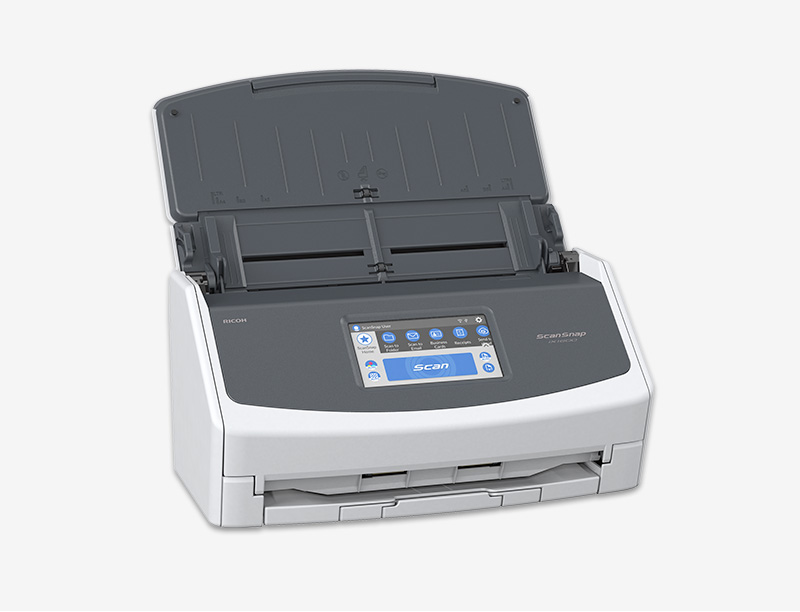Versatility and ease of use are the two key factors for choosing which home scanning device to invest in
A home document scanner can be a valuable addition to any modern household. The transition to hybrid work models has seen more households invest in home scanning devices than ever before, with the global market expected to grow to $8.7 billion by 2032.
Whether it’s for a home office or a family common area, having immediate access to high quality document scanning from the comfort of your home can save families considerable time and expense. It can help keep finances in order, capture valuable memories, and minimize the time spent on clerical work that could otherwise be spent enjoying the comforts of home.
But with the wealth of options available, it can be tough to know where to start. Do you really need a scanner/printer combo? How big does a home scanner need to be? And how can you be sure it can handle everything you’ll need it to? Read on for the answers to these and other questions that will help you feel confident in your decision to invest in the right device for your household.
Check out our guide, Document Scanners: Everything You Need to Go Digital, for even more expert advice and information.
What is a home document scanner?
A home document scanner is any digital document imaging device that has been expressly designed for use in the home rather than in an office. Unlike scanners intended for use in working environments, home scanning devices tend to be smaller and prioritize smoother designs and more straightforward functionality in contrast to the sophistication and utility of an office document scanner. They’re intended to harmonize with the spaces we inhabit on a regular basis, offering a pleasing interaction at a fraction of the footprint.
Top uses for a home document scanner
Whether you’re equipping your home office or trying to make it easier for your family to digitize important documents and keepsakes, a home document scanner is a worthwhile investment. The most useful scanners don’t simply create digital replicas of physical files; they can also make it easier to manage paperwork and help preserve treasured memories.
Best home document scanners for important files
If you spend the early months of the year preparing for tax season — whether for yourself or a small business — having a tax scanner is a must. These specialized home document scanners allow users to upload documents directly to software like Microsoft Excel and QuickBooks by using optical character recognition (OCR) to make scanned text searchable and indexable. Look for models with scanning speeds of 20 to 40 pages a minute and an automatic document feeder to get the most out of your investment.
Best home document scanners for photos
It’s time to bring those bulky photo albums into the modern era. Photo scanners make your memories more accessible and shareable by creating digital replicas of physical photographs. Printed pictures are vulnerable to the effects of time, so digitizing these files is the best way to preserve them long-term.
Look for photo scanners that focus on image quality to ensure best results. Automated features like red-eye reduction, color enhancement, and fade correction can even improve the overall quality of your photographs and make older images look new again.
Best home document scanners for receipts
Receipts can be tricky to digitize. They’re often printed on heat-sensitive thermal paper, meaning they fade and degrade more quickly than documents printed on standard copy paper. Having a dedicated receipt scanner makes it easier to preserve that information — your future self will thank you when it comes time to file taxes or submit reimbursements for work.
Like with tax scanners, receipt scanners should offer OCR functionality. This way, you can categorize your receipts as you scan them, rather than having to input all of that data manually.
How to choose a home document scanner
To find the best scanner for you, first take a step back and evaluate what your needs are. Think about what you’ll use it for, and where you’ll keep it — will it live on a desk, for example, or be stowed away in a cabinet between uses? Once you’ve got a vision of how a scanner will live and work with you, you can find the ideal home document scanner without overinvesting or choosing a model that can’t keep up.
Know your home document scanner needs
Any potential technology purchase should be examined through the lens of the value it will bring. Understanding exactly what that means depends largely on what it will be used for.
Will you be scanning financial documents or homework assignments? Handwritten notes or school art projects? Architectural blueprints or precious family photographs? If you’re confident that you’ll only ever need it for a single use case, it’s likely in your best interest to shop for a specialized scanner that meets your unique needs.
What’s more likely, however, is that you’ll need your new home document scanner to accommodate a variety of jobs from multiple members of your household. It’s not unlikely that you could be scanning an important health form to send to your MD the same day that your child wants to scan their drawing of a green dinosaur so they can edit it on a computer. To ensure that you get the most out of your investment, any home scanning device you choose should be easy to use, reliable, and capable of handling a wide range of scanning projects. The more versatile, the better.
Did You Know? The ScanSnap iX1600 is a versatile, could-enabled scanner that scans up to 40 pages per minute. Click here to find out why our customers love it.
Measure twice, buy once
A big part of choosing the right device for your household is considering how it will fit into your living space. Unlike office environments that have been designed to accommodate the needs of full time knowledge workers, our homes typically prioritize comfort, and rightfully so. To ensure that you’re not making unwanted interior decoration compromises for the sake of your new scanner, it’s best to come to an agreement with the other members of your household as to where it will live in the house before making your purchase.
If it’s intended as a shared family device, placing your scanner in a kitchen or living room ensures that anyone in the family can have access to it at most times of day. Keep in mind that the average kitchen countertop is only 25 ½ inches deep and likely wouldn’t be able to accommodate larger flatbed scanners with lids that could collide with cabinetry above. Your best bet would be to go with a more compact yet versatile option like the award-winning ScanSnap iX1600, with a total depth of only 6.3 inches, allowing plenty of room for additional storage and maneuverability when scanning documents.

The same goes for any home document scanner you might be considering for your home office. After the COVID-19 pandemic forced many businesses into a hybrid work structure, many employees found themselves having to build home offices on a budget. Even those fortunate enough to receive financial support from their employers had to keep purchasing decisions within reason. At the time of writing, the best selling home office desk on Amazon measured in at just 23.6 inches in depth, making it all the more important to keep device sizes to a minimum.
No matter where you choose to place your new scanner, be sure to take your measurements in advance, check the specific product dimensions, and ensure that you’re leaving yourself enough room that your surfaces won’t feel crowded by the new addition.
Not much can ruin a peaceful afternoon at home faster than waking a napping baby thanks to a noisy, poorly made scanner. Whether you’re trying not to wake a sleeping child or a family member working shifts, a home scanning device capable of operating quietly can be worth its weight in gold. When considering your options, be sure to look for a product that’s constructed from quality materials and a minimum of moving parts.
The mechanisms that feed documents through the scanning aperture should follow a straight paper path to avoid any jams that could result in a document needing to be removed from the device by hand. Hinges and locking mechanisms should use mechanical fixtures and minimize reliance on pressure fits. Finally, any feedback from button presses or networked jobs should be toggleable to minimize unwanted or unexpected noise pollution.
Did You Know? PCMagazine described the RICOH ScanSnap iX1600 as “a snappy, accurate portable document scanner that's excellent for digitizing documents.” Click here to read the full review and learn why it earned a 4.0 out of 5 and a place among their best tech products of 2021.
Our recommendation: RICOH ScanSnap iX1600
We know that you have no shortage of options when it comes to choosing a home document scanner. We pride ourselves on having spent the last 50+ years designing and developing some of the most beloved electronics in the world, including our line of award-winning, easy to use, one touch ScanSnap scanners.
The RICOH ScanSnap iX1600 is a versatile, cloud enabled scanner that can fit on nearly any household surface and boasts exceptional reliability. Designed for everyday use, the ScanSnap iX1600 gets documents digitized, organized and sent to wherever – whenever - with minimal effort. We believe it’s the ideal choice for anyone looking to add a home scanning device to their household, and we hope you’ll agree. Click here to learn more and shop the full line of ScanSnap scanners.
Note: Information and external links are provided for your convenience and for educational purposes only, and shall not be construed, or relied upon, as legal or financial advice. PFU America, Inc. makes no representations about the contents, features, or specifications on such third-party sites, software, and/or offerings (collectively “Third-Party Offerings”) and shall not be responsible for any loss or damage that may arise from your use of such Third-Party Offerings. Please consult with a licensed professional regarding your specific situation as regulations may be subject to change.









